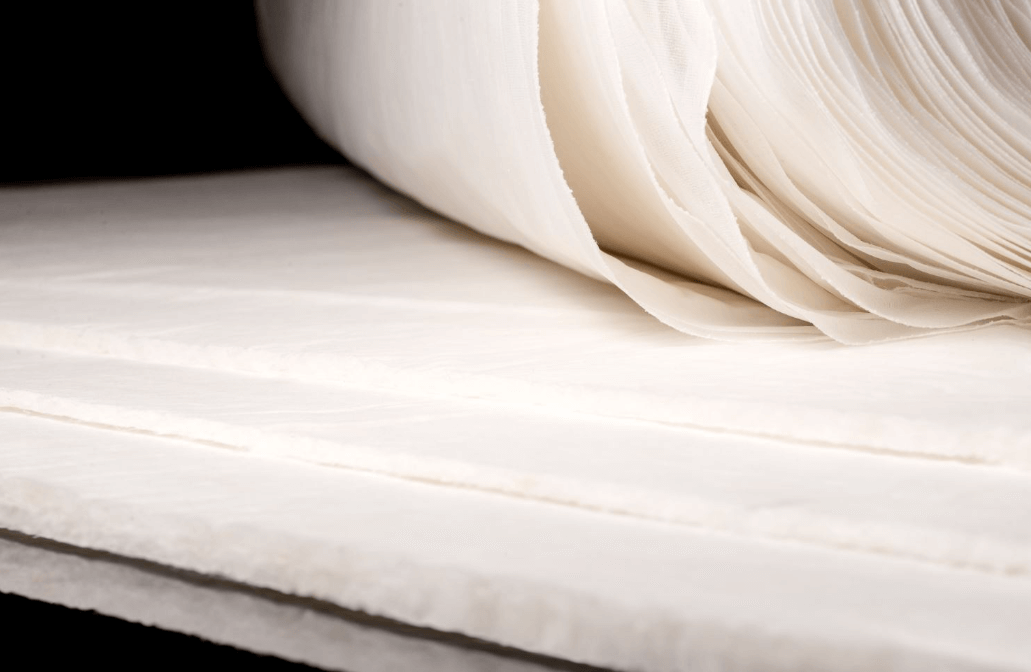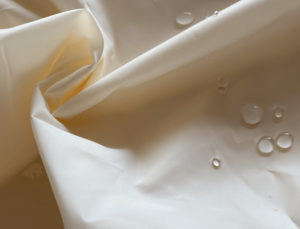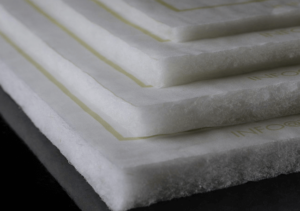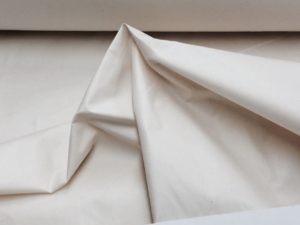A Details Guide On Down Fabric Material

Ammy Harryy, a devoted advocate for sustainable fashion and mindful…
Finding the right fabric for your project can be daunting. There are so many types of materials to choose from, each with their own unique set of benefits and drawbacks.
This guide will help you navigate the world of fabrics and find the perfect material for your needs.
Whether you’re looking for a durable down fabric that can withstand wear and tear, or a soft and comfortable option, we’ve got you covered. Keep reading to learn more!
What Is Down Fabric?
There are many types of materials that can be used to fill a pillow, such as down, feathers, synthetic fibers, or even recycled polyester.
This web page, available on your mobile devices, will explain about down. Down material is biodegradable and comes from the webbing between a bird’s feathers.
The webbing is carefully removed by hand and then cleaned before it is used to fill a pillow. Feathers are also biodegradable material and come from the protective outer layer of a bird’s feathers.
The feathers are carefully harvested and then cleaned before they are used to fill a pillow. Synthetic fibers are made from petroleum products and are not biodegradable.
They are often made from recycled polyester, which is a type of plastic that has been melted down and reformed into fiber.
Synthetic fibers are often used to fill pillows because they are less expensive than natural fibers and they hold their shape better over time. However, synthetic fibers can be uncomfortable and they may cause allergic reactions in some people.
History Of Down Fabric
The history of down can be traced back to early organic materials used for insulation and stuffing.
The first recorded use of down dates back to 1780, when it was used as material for hot-air balloons.
It was not until the early 20th century that down began to be used in clothing. The first down garments were made for arctic explorers, who valued the material for its warmth and lightweight
In the years since, down has become a popular material for both casual and outdoor clothing.
Today, Down is produced in several different forms, each designed for a specific purpose. The most common type of down is goose down, which is used in a variety of garments including jackets, sleeping bags, and comforters.
Duck down is another popular type of down, which is often used in quilts and pillows. Other less common types of down include eiderdown and ostrich down.
The production of down typically involves four steps: material selection, cleaning and sorting, filling and finishing.
Down is usually sourced from ducks or geese that are raised specifically for their feathers. Once the feathers have been collected, they are cleaned and sorted into different grades based on their size and weight.
The feathers are then filled into a bag or quilt using a specialized machine. Finally, the down is stitched into place and the garment or product is ready to be sold.

How Sustainable Is Down Fabric?
Down is a type of insulation that is made from the soft, fluffy feathers of ducks or geese. It is an excellent insulator because it traps warmth and prevents heat loss.
Down is also lightweight and compressible, making it ideal for use in clothing and bedding. However, some people are concerned about the sustainability of down fabric.
Down is generally considered to be a sustainable resource. Ducks and geese are not killed in order to harvest their feathers, and the birds are not harmed during the process.
In addition, down is a natural material that biodegrades easily. However, there are some environmental concerns associated with down production.
The packaging and transportation of down can use a lot of resources, and down-filled products often contain synthetic materials that are difficult to recycle.
In addition, some companies use live plucking, which is a method of harvesting feathers that is considered to be cruel. As a result, not all down products are created equal in terms of sustainability.
Down is generally considered to be a sustainable resource, but there are some environmental concerns associated with its production.
These concerns should be taken into account when deciding whether or not to purchase down-filled products.
What Makes Down Fabric A Sustainable Option?
Today, more and more consumers are looking for sustainable options when it comes to the products they purchase. And when it comes to fabrics, down is a sustainable choice. Here’s why:
Down is a natural product that is created from the feathers of ducks and geese. The feathers are a by-product of the poultry industry, which means that no new land has to be created to produce down.
In addition, data shows that the global down market is growing at a rate of 4% per year. This means that there is little need for down farmers to increase their output, as there is already sufficient demand for the product.
Down is also a highly efficient fabric. It is extremely lightweight and provides insulation against both warm and cold temperatures.
As a result, less fabric is needed to create a garment that is suitable for both winter and summer wear.
In addition, down garments can be customized to the individual wearer’s body type, providing an optimal fit and value.
Finally, down fabric is easy to care for. It can be machine washed and dried, and does not require special care or cleaning products. Therefore, it is a suitable option for those who are looking for a low-maintenance fabric.
In conclusion, down fabric is a sustainable option for those who are looking for a durable, efficient, and easy-to-care-for fabric.
How Is Down Turned Into Fabric?
Down is a layer of fine feathers found under the tougher exterior feathers of ducks, geese, and other waterfowl. It is used in fashion as an insulating layer in clothing.
It is considered vegan because the birds are not killed for their down and it can be harvested without harming the birds.
The fashion industry’s use of down has come under increased scrutiny in recent years due to public concern about the treatment of animals used for meat production.
Down’s intricate manufacturing process begins with the parsing of the bird’s body into small pieces. The small fluff-filled structures that make up down are extracted and sorted by quality.
The finest down is used in fashion garments, while lower quality down is used in products like sleeping bags and bedding.
The sorting process is repeated several times to remove any foreign bodies or debris that could affect the quality of the down.
Finally, the down is cleansed with a gentle detergent before it is ready to be used in fashion garments.
The delicate nature of down means that it must be handled with care during all stages of its manufacture.
This attention to detail ensures that fashion garments made with down will be of the highest quality and will keep their wearer warm and comfortable.
The Pros Of Down

Here are a few pros of down:
Layout
A “down” layout is where the fill material is on top of the baffle fabric. The advantage of this type of layout is that it drapes better and can show off the material design of the baffles better. The down can also be fluffed up to provide more loft and insulation.
Clothes
You will often see down used in high-end jackets and sleeping bags because it is such an efficient insulator. When you compare it to synthetic fill, down is much lighter weight for the same warmth.
Energy
Down is an excellent insulator because it traps small pockets of air. These pockets of air act as a barrier to heat loss. Cotton does not have these same pockets of air, so it does not insulate as well.
Leather
Another great thing about down is that it is water resistant. This means that if you are caught in a rainstorm, your down jacket will still keep you warm.
Sheets
If you are looking for a way to make your bed more comfortable, you may want to consider using a down comforter. Down is a great insulator, so it will keep you warm in the winter and cool in the summer.
Organic Matter
One final advantage of down is that it is an organic material. This means that it is biodegradable and does not harm the environment when it is produced.
The Cons Of Down
Icons are small images that represent an object, idea, or action. They are often used as graphical representations of menu commands, shortcuts, or buttons. icons are commonly found on computer desktop applications and websites.
While icons can be very helpful in providing a visual representation of what something does, they also have some potential drawbacks.
Among few examples is, that icons can be difficult to interpret. A designer may think an icon is self-explanatory, but a user may not have the same understanding. icons can also be overloaded with too much information.
When icons are used to represent multiple objects or ideas, they can become confusing and overwhelming.
Additionally, icons need to be carefully designed so that they’re aesthetically pleasing and easy to understand. If an icon is poorly designed, it can actually detract from the overall user experience.
Icons are often manufactured from wood or other materials. As a result, they can be fairly expensive to produce.
In addition, icons may need to be replaced periodically due to wear and tear. icons can also take up a lot of space on a display board or work surface.
When placed side-by-side with other icons, they can quickly become cluttered and difficult to interpret. Finally, note that some users may have difficulty seeing or interacting with icons due to vision impairments or motor disabilities.
While icons offer some potential benefits, it’s important to weigh the pros and cons before using them in your own designs.
Down Clothing Brand
Down is a type of insulation used in jackets, sleeping bags, and other cold-weather gear. It is made from the soft undercoating of ducks and geese, and it has a number of advantages over synthetic insulators.
For example, down is an excellent insulator; it has a feature to trap heat extremely well, even when wet. Second, it is very lightweight and compressible, making it ideal for use in active pursuits like climbing and backpacking.
Finally, down is durable and long-lasting; with proper care, a down jacket can last for many years.
Down clothing has come to be synonymous with high-quality cold-weather gear, and Down clothing brand is one of the most respected names in the business.
Whether you’re looking for a warm winter coat or a cozy sleeping bag, Down Clothing Brand has what you need to stay comfortable in the coldest conditions.
The Impact Of Down Fabric

Down is a type of insulation that is made from the soft, fluffy underside of feathers.
It is an excellent choice for clothing and bedding because it is light, warm, and breathable. However, down also has a significant environmental impact.
The production of down requires the removal of large amounts of feathers from birds, which can cause stress and injuries
In addition, many brands use unethical methods to obtain down, such as force-feeding or live-plucking.
Furthermore, the manufacturing process often involves harsh chemicals that can pollute the air and water.
Finally, down is often packaged in plastic, which creates additional waste.
For these reasons, it is important to be aware of the components of your down products and to choose brands that use sustainable practices.
Impact Of Down On Planet
Down is a term for the soft, fluffy undercoat that certain birds have. This layer of feathers is found below the outer feathers and helps to insulate the bird against cold weather.
Down is also used in the production of a variety of products, including pillows, comforters, and sleeping bags.
Down is prized for its insulation properties, as it is able to trap heat while remaining lightweight and breathable. However, there are some concerns about the impact of down on the environment.
Down is typically sourced from ducks or geese, and most of the down used in commercially-produced products comes from these birds.
However, down can also be sourced from other animals, including rabbits and even cats. The sourcing of down often raises concerns about animal welfare, as many of these animals are kept in cramped and unsanitary conditions.
Moreover, the plucking of down can be painful for birds, and it is not uncommon for them to be wounded or killed in the process.
As a result, there is a growing movement to source down only from humanely-raised animals.
In addition to animal welfare concerns, there are also environmental concerns associated with down production.
The cleaning and processing of down generates a significant amount of waste water, which can pollute nearby waterways.
Moreover, the use of harmful chemicals in the cleaning process can damage local ecosystems.
As a result, it is important to choose Down products that have been sourced and processed responsibly.
Impact Of Down On Animal And People
Every winter, animals and humans alike suffer from the cold weather. One way to combat the cold is by using down. Down is a layer of soft, fluffy feathers that are found under the tougher outer feathers of bird
It is an excellent insulator and has been used for centuries to keep people warm. Down is also used in a variety of other products, including Pillows, comforters, sleeping bags, and even clothing.
There are several reasons why down is such an effective insulator.
First, down feathers are very light and airy, which makes it easy for them to trap heat.
Second, down has a natural ability to loft, or fluff up. This allows it to create more surface area, which in turn traps more heat.
Finally, the individual down feathers are interconnected, which prevents heat from escaping.
While Down is an excellent insulator, it does have some drawbacks.
First, it can be quite expensive. Second, down is not vegan-friendly as it comes from animals. Finally, down can lose its loft over time, which decreases its ability to trap heat.
Despite these drawbacks, down remains one of the best options for staying warm in cold weather.
Conclusion
So, what do you think? Are down materials the next big thing in insulation?Or are they simply a passing fad?
The jury is still out on this one, but there’s no harm in keeping an eye on them and seeing how the market develops.
In any case, we hope you enjoyed this post and that it gave you a good introduction to the world of down materials. Stay warm!
More Sustainable Guide You’ll Love to read:
Apple Leather Fabric Guide (Everything You Want to Know)
Sustainable Viscose Fabric Material Guide
Seacell Fabrics Material Guide For Fashion Designer
Cork leather, a Sustainable material?
Wool Fabric Guide, Everything you need to know
Get to know about Econyl Fabric
Vegetable Tanned Leather Material Guide
A Details Guide On Silk Fabric Material
What Is Camel Fabric,How It Made?(Everyhing You Want To Know)
Details Material Guide On Cashmere Fabric
What is Alpaca Wool Fabric? History, How It’s Made
Recycled Polyester Fabric Details Guide
Cupro Fabric Material Guide (Is It Sustainable?)
Woocoa Fabric Material Guide (Why It’s Expensive)
Organic Bamboo Fabric Guide (Eco Friendly)
Modal Fabric Guide (Everything You Need to Know)
Sustainable Ecovero Fabric Material Guide (All Details)
Details Material Guide On Pinatex Fabric
A Details Guide To Scoby Leather Fabric
Ammy Harryy, a devoted advocate for sustainable fashion and mindful living, exudes a profound passion for nature and the environment. Her mission intertwines style and consciousness, inspiring eco-friendly choices. With her words, Ammy envisions a world where fashion harmonizes with the planet, urging readers to take small steps toward a greener future.



